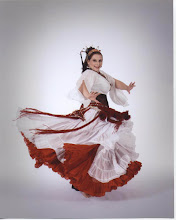I've spent years studying belly dance throughout history. Where did it all begin? Has it changed? How has it changed? Is it the same everywhere it's danced? Etc, etc, etc. You know - those questions that historians ask. ;)
Most performing arts are very poorly documented throughout most of history. The art itself does not survive past the performance until the invention of video - so historians are forced to rely on artistic representations and written description. Both are poor sources for what was actually done. In addition to that is that in many cultures no one bothered to record in any way information about dance. So most of the early ages are pure theory. Now this doesn't mean that I believe that you just throw up your hands and go and do whatever you want. There are many areas of history and in science where theory is all we have. So you base your theory on solid facts and be prepared to rethink your position as new information becomes available. Nothing wrong with that at all.
So what facts do we have about the beginnings of belly dance? Good Question! The answer is not many. We know that dance of some kind was done as a part of religious worship in the the same geographic area. Some of the descriptions and very few depictions give us the idea that this early dance was related to belly dance. This seems to be a commonly held belief among most of the scholars doing research in this area. Most dance historians of any kind believe that dance in general began as part of spiritual and religious beliefs. So it's not really a great surprise that belly dance might have begun in a similar way. However there is little documentation that the dance done by the priestesses in that geographic area was the same (as in unchanged) from what we do today and know as belly dance. After all wild maize (corn) doesn't look anything like the genetically domesticated corn that we eat today! So why should the dance which is even more fluid and easily changed than a plant?
So we leave the myst of the ancient days and move into more documented times. There were many early cultures in that area of the word Sumerian, Babylonian, Egyptian, Persian that were fairly well documented. Unfortunately none of the ancient cultures left much direct information on dance. That they danced is a definite. How they danced is the question. This is the era that I believe where the sacred dance began to change and be used in a secular sense. The sacred and the secular lived side-by-side. This was the first large sweeping change to what eventually became known as belly dance. There are artistic depictions of dance in some of these cultures. Ancient Persia has many vases and murals from this period that depict dance and they regularly imported Greek dancing girls. Ancient Egypt has some wonderful artwork that depicts dance - but it doesn't particularly look like modern belly dance. For examples of Ancient Egyptian dance read Irena Lexova's book, "Ancient Egyptian Dances". The dance appears to be more angular and more acrobatic than modern belly dance. There are ancient texts that discuss "quivering thighs" and this definitely sounds more like what we know as belly dance, so I definitely believe that the dance existed. The question is in what form? What music did they dance to? This has to affect the dance! It certainly affects dance today. At this point we know that women were still dancing publicly. Did men dance this dance during this period? Did men and women dance together? All good questions and mostly the answer is it depends on the culture. Just like today, belly dance or it's form at this time, was greatly affected by the culture. Men definitely danced in the ancient world even the bible discussed Solomon dancing in the streets and the temple. The question isn't did men dance - the question is did they belly dance? Did they belly dance with women? Men and women were often segregated in the ancient world. There are still placed today where this is true. Certainly it was true in history. All good questions and all important when tracing the dance.
For the Middle East, the next period is the one where even more specific information on belly dance becomes available. The birth of Islam and it's spread across the area affected belly dance in a most significant way. The world changed dramatically and all of culture and society was affected by that change. Women and their role in society was perhaps affected most of all.
To be continued . . . . .
Subscribe to:
Post Comments (Atom)




No comments:
Post a Comment